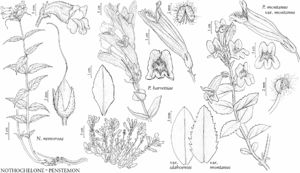Difference between revisions of "Penstemon barrettiae"
Syn. Fl. N. Amer. ed. 2, 2(1): 440. 1886.
FNA>Volume Importer |
FNA>Volume Importer |
(No difference)
| |
Revision as of 18:29, 24 September 2019
Subshrubs, sometimes cespitose. Stems ascending to erect, 13–40 cm, glabrous, glaucous. Leaves persistent, 3–5 pairs, short-petiolate or sessile, 15–80 × (5–)11–28 mm, blade elliptic to ovate, oblanceolate, or spatulate, base tapered to clasping, margins entire or irregularly serrate to serrulate, apex rounded to obtuse or acute, glabrous, glaucous. Thyrses continuous, secund, 7–13 cm, axis glabrous, verticillasters 6–8, cymes 1- or 2-flowered; proximal bracts ovate, 7–28 × 3–17 mm; peduncles and pedicels ascending to erect, glabrous. Flowers: calyx lobes ovate to lanceolate, 5–7.5 × 2.2–3.5 mm, glabrous or inconspicuously glandular proximally; corolla lilac to purple, essentially unlined internally but abaxial ridges usually lilac or white, not personate, funnelform, 33–38 mm, glabrous externally, sparsely to densely white-lanate internally abaxially, tube 6–8 mm, throat 7–10 mm diam.; stamens included, pollen sacs 1.2–1.6 mm; staminode 7–13 mm, essentially terete distally, 0.1 mm diam., tip straight, glabrous; style 20–26 mm. Capsules 8–10 × 5–7 mm. 2n = 16.
Phenology: Flowering Apr–Jun.
Habitat: Basalt cliffs, outcrops, talus slopes.
Elevation: 70–300 m.
Discussion
Penstemon barrettiae is known from along the Columbia and Klickitat rivers in Hood River, Multnomah, and Wasco counties, Oregon, and Klickitat County, Washington.
Selected References
None.
